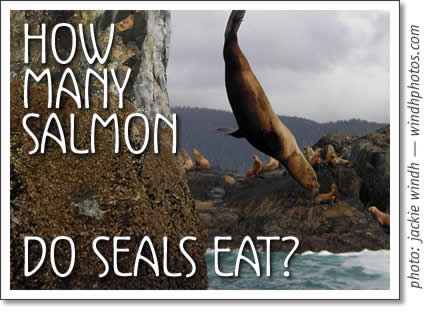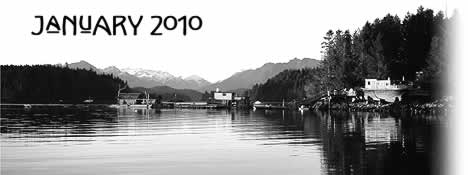
How much salmon do seals eat?
by Katie Beach, Tofino
This is the second article in a series exploring the decline of Clayoquot salmon populations.
![]() Clayoquot salmon populations are declining, but why? A number of factors affect salmon populations, including predation from humans, marine mammals, birds, and other species of fish (including larger salmon). And predation can be a big deal. Some studies in British Columbia have estimated that up to 75% of pink salmon fry entering the sea are lost to predation in the first 45 days. This problem is exacerbated when the food source for juvenile salmon is low. In those cases, juvenile salmon often leave the protection of the coast to forage further offshore where the risk of predation increases fivefold.
Clayoquot salmon populations are declining, but why? A number of factors affect salmon populations, including predation from humans, marine mammals, birds, and other species of fish (including larger salmon). And predation can be a big deal. Some studies in British Columbia have estimated that up to 75% of pink salmon fry entering the sea are lost to predation in the first 45 days. This problem is exacerbated when the food source for juvenile salmon is low. In those cases, juvenile salmon often leave the protection of the coast to forage further offshore where the risk of predation increases fivefold.
A main family of predators is the pinniped family, which includes seals and sea lions. These species have bad reputations, partly because they are not too shy to hang around fishing boats or aquaculture pens waiting to take a fish off of a line or bite through a net. But they may not eat as much as perceived. A 1993 study in the Georgia Strait found that seals eat about 4.3% of their body weight per day, averaging 1.9kg (Olesiuk 1993). An analysis of scat samples indicated that two food species made up the bulk of the seals' diets: from April to November, the seals in the study ate mainly Pacific hake, and from December to March, they mostly ate Pacific herring. In the study, only about 4% of the diet of the seal population was salmon. And while studies of this kind have not yet been done on the west coast of Vancouver Island, we can assume similar food preferences and ratios for the local population.
It appears as if only a limited number of individuals in a population can be troublesome. One researcher (Herder, 1983) found that although his study area had up to 200 harbour seals in a particular river area, only nine seals were responsible for pillaging gillnets each day. When those problem animals were removed, predations on vulnerable salmon populations were greatly reduced.
Even so, 4% of a seal's body weight can make up a significant fraction of the salmon population and could lead to localized depletion, depending on the number of seals in an area. The effects become even more important in human-altered environments such as around damns, locks, and fish farms. For instance, observations on the Puntledge River on the east side of Vancouver Island note that harbour seals forage on chum fry and coho smolt at night by using the lights from bridges to silhouette the fish and aid in their capture. Another example of localized depletion comes from the Georgia Strait, where UBC's Dr. Carl Walters contends that seals may be taking up to 20% of the salmon. Walters has suggested that decision makers need to consider killing seals and sea lions to help maintain salmon stocks, but that the politics may never allow for marine mammal culls. Indeed, stories of culls of eagles, bears, seals, basking sharks, mallard ducks, and other species in the 1900s make many people cringe today, especially when recognition of ecosystem interactions became more widespread.
Limited studies have looked at ecological interactions. Some have shown that removing too many marine mammals may actually be detrimental to the salmon populations. Seals and sea lions also eat other fish that prey on salmon, and these predatory fish may be greater consumers of salmon than marine mammals or sea birds. But, how many are too many?
Local Nuu-chah-nulth traditionally hunted seals and sea lions, eating the meat and using the skins for floats.
Tla-o-qui-aht member Joe Martin has a lot to say about seal-salmon interactions. He notes that the seal population has grown substantially since he was young. "People used to use them as a food resource, but not for sport. When you consider that 7,000-10,000 people lived in Tla-o-qui-aht Ha'houlthee, then you can imagine that a lot of seals were killed," Martin said.
Today people don't hunt seals anymore, (Martin says that they prefer hamburgers) and without top predators, seal populations have exploded. This scenario worries Martin. When salmon stock levels are this low, they can't handle the predation. "They might not be eating lots, but they are having an effect," Martin said. Taking humans out of the interaction doesn't necessarily return the ecosystem to a natural stage. "In former times, people were part of [the ecosystem]."
Seals and sea lions do affect Clayoquot salmon populations, but whether that impact is negative or positive is not yet well understood. Marine mammals are only one of many potential factors impacting local salmon stocks.
This is the second article in a series exploring the decline of Clayoquot salmon populations. In my next article, I will explore impacts on freshwater habitat as a potential limiting factor for local salmon stocks.
Katie Beach is a biologist for the Nuu-chah-nulth Tribal Council. The opinions expressed are the author's. She lives in Tofino.
Tofino Time January 2010
- Tofino in January
- Tofino tides: Tide table for Tofino January 2010
- January concerts in Tofino
- January movies in Tofino
- Bear Smart Myths: Reporting a Bear in Tofino
- Just another day for the birds
- Horoscope for January 2010
- The art of the Tofino soapbox
- Community Directory: Goods & Services in Tofino
tofino | tofino time | activities | accommodation | events | directory
maps | travel | food | art & artists | photos | horoscope | tides
search | magazine | issues | articles | advertising | contact us
hosted in tofino by tofino.net & studio tofino
© 2002-2019 copyright Tofino Time Magazine in Tofino Canada
Tofino biologist Katie Beach on the impact of seals on salmon stocks in Clayoquot Sound.

quick links:
- tofino accomodations
- tofino calendar
- tofino surf report
- tofino horoscope
- march horoscope
- tofino map
- tofino fishing report
- tofino tides
- tofino weddings
tofino events:
- tofino concerts
- tofino events
- tofino movies
- tofino festivals
- tofino yoga classes
- tofino whale festival
tofino time magazine:
- tofino time march 2016
- tofino event listings march 2016
- tofino concerts in march 2016
- tofino movies in march 2016
- cox bay | wickaninnish beach
- chesterman beach
- tonquin beach
- tofino brewing co.
- tofino wedding guide
tofino accommodation:
- tofino cabin
- tofino camping
- bed & breakfasts in Tofino
- tofino hostels
- tofino motels
- tofino hotels
- tofino vacation rentals
- petfriendly accommodation
activities:
- tofino bike rentals
- tofino bear watching
- tofino bird watching
- tofino boat charters & cruises
- tofino fishing
- hot springs cove
- sea kayaking in tofino
- tofino storm watching
- tofino surfing
- tofino whale watching
- tofino yoga
shopping:
services:
- tofino yoga, spa & wellness
- tofino restaurants
- tofino internet cafes
- tofino travel & transportation
- tofino real estate
- tofino taxi services
- tofino wedding & events
